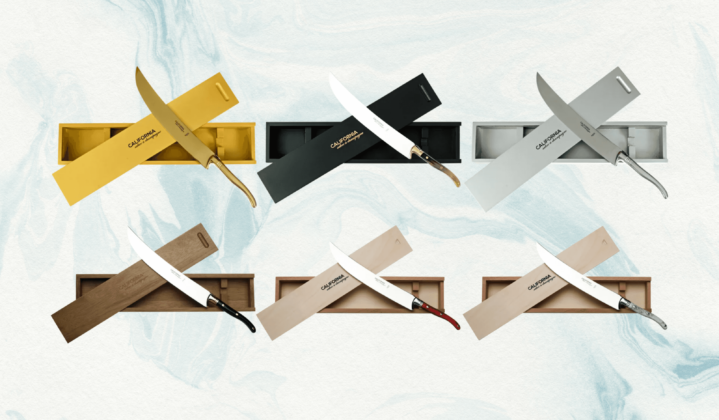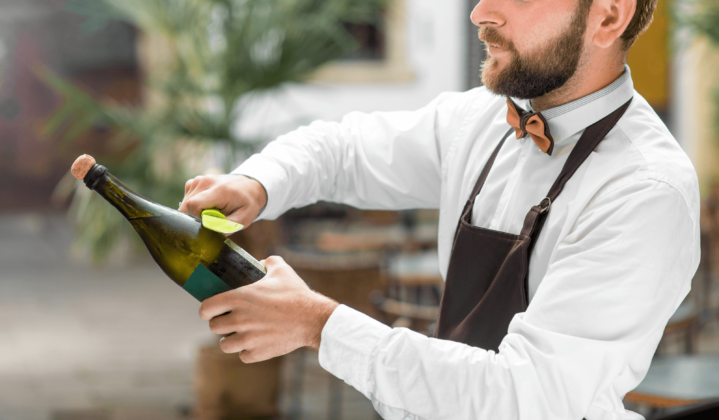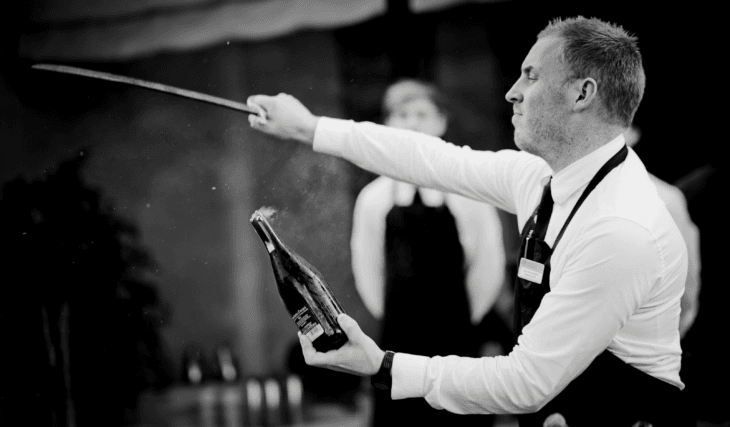What is Sabrage? Understanding the Art, Tradition, and Celebration of Champagne Sabering
A Unique Celebration
Have you ever wondered what it feels like to be the one holding the saber, ready to mark a moment that everyone will remember? The weight of the saber in your hand, the anticipation building around you—it’s a rush unlike any other. In that instant, you’re more than just a part of the celebration; you’re the one about to create a memory that will linger long after the last glass is emptied. That’s the effect of sabrage.
Sabrage is the ceremonial practice of opening a champagne bottle with a saber, where a single, precise stroke sends the cork and bottle neck flying. It’s more than just a method—it’s a dramatic display that transforms an ordinary toast into something extraordinary. The thrill of sabrage captures the magic of the moment, igniting excitement and adding a sense of grandeur to any celebration.
With one swift, deliberate motion, the cork flies, and in that instant, the room lights up with excitement. Sabrage has the power to turn a simple celebration into an unforgettable experience, leaving everyone talking about it long after the night is over.
Symbolism and Tradition of Sabrage

Sabrage is steeped in history, its origins tracing back to the Napoleonic era in early 19th-century France. The story goes that after the French Revolution, Napoleon Bonaparte’s army was famed for swift victories across Europe. The cavalry officers, known as Hussars, were young, dashing, and often celebrated their successes with champagne—a symbol of luxury and victory.
As they rode on horseback, traditional bottle-opening methods were impractical. Instead, they would use their sabers to swiftly open bottles in a display of panache and confidence. This act became a symbol of their fearless spirit and joie de vivre.
Napoleon himself was quoted saying, “Champagne! In victory one deserves it; in defeat one needs it.” This sentiment captures the essence of sabrage as both a celebration of triumph and a comfort in challenging times.
Symbolic Meanings of Sabrage
- Victory and Triumph: Sabrage commemorates overcoming obstacles and achieving success, echoing its military roots.
- Courage and Confidence: The boldness required to saber a bottle reflects personal bravery and assurance.
- Celebration of Life: It’s a toast to life’s milestones, big or small, embracing joy with flair.
Sabrage vs. Modern Bottle-Opening Techniques

While modern methods prioritize convenience and efficiency—twist-off caps, corkscrews, and pressure releases—sabrage stands apart as an intentional act of ceremony. It’s less about the utility of opening a bottle and more about creating a moment that captures attention and ignites celebration. In an age of instant gratification, sabrage invites us to pause and savor the ritual.
Occasions Perfect for Sabrage
Sabrage is a versatile addition to a variety of events, infusing them with excitement and elegance. Here are some occasions where sabrage can enhance the experience:
Traditional Celebrations:
- Weddings: Mark the union of two people with a dramatic gesture that symbolizes the start of a shared journey.
- Anniversaries: Celebrate enduring love and commitment with a nod to tradition.
- New Year’s Eve: Ring in the new year with a burst of excitement, setting a jubilant tone for the months ahead.
Milestones and Achievements:
- Graduations: Honor academic accomplishments and the beginning of a new chapter.
- Promotions and Retirements: Recognize professional achievements and transitions with a memorable toast.
- Birthdays and Coming-of-Age Ceremonies: Add flair to significant personal milestones.
Corporate and Social Events:
- Product Launches: Create buzz and media interest with a visually captivating sabrage ceremony.
- Charity Galas: Engage attendees and encourage generosity by starting the event with a bang.
- Cultural Festivals: Incorporate sabrage into celebrations that honor heritage and tradition.
Sabrage not only elevates the atmosphere but also creates lasting memories. The shared experience of witnessing or performing sabrage fosters a sense of connection among guests, making the occasion truly special.
Technique Behind Sabrage
At first glance, sabrage may seem like a feat reserved for the daring or the skilled, but understanding the technique demystifies the process and reveals an interplay of physics and finesse.
Essential Steps of Sabrage:
- Chill the Bottle Properly: The champagne bottle should be thoroughly chilled to around 45°F (7°C). This isn’t just for taste—the cold temperature increases the internal pressure and makes the glass more brittle, facilitating a clean break.
- Remove the Foil and Cage: Carefully unwrap the foil and remove the wire cage that holds the cork in place. This exposes the lip of the bottle where the saber will make contact.
- Find the Seam: Every champagne bottle has two seams where the glass was fused during manufacturing. Locate one of these seams as it will guide the saber.
- Hold the Bottle Correctly: Grasp the bottle firmly at the base with your non-dominant hand, keeping your thumb in the punt (the indentation at the bottom). Tilt the bottle away from yourself and any spectators at a 45-degree angle.
- The Swing: With the saber in your dominant hand, lay it flat against the bottle with the blunt edge facing the lip. In one smooth, confident motion, slide the saber along the seam toward the lip, striking it firmly.
- The Result: The force and angle cause the glass at the lip to break cleanly, propelled by the champagne’s pressure. The cork and collar fly off together, and the champagne is ready to pour.
Physics Behind Sabrage
Champagne bottles are under significant internal pressure—about 90 pounds per square inch (psi), which is roughly three times the pressure in a car tire. This pressure is due to the carbon dioxide produced during the secondary fermentation that gives champagne its signature bubbles.
When the saber strikes the lip of the bottle, it doesn’t cut through the glass; instead, it creates a shock at the weakest point where the seam meets the lip. The combination of the saber’s impact and the internal pressure causes the glass to fracture cleanly. The pressure then expels the cork and broken glass collar forward, away from the bottle, ensuring that the remaining champagne is safe to drink.
Understanding this interplay of technique and physics not only makes sabrage safer but also deepens the appreciation for this elegant tradition.
Champagne and Sabrage: Choosing the Right Bottle
Selecting the appropriate champagne is crucial for a successful and safe sabrage. Not all bottles are suitable, and understanding the characteristics to look for can enhance the experience.
Types of Champagne Best Suited for Sabrage:
- Non-Vintage Brut Champagne: Standard non-vintage champagnes are ideal due to their consistent pressure and bottle design.
- Quality Sparkling Wines: Certain high-quality sparkling wines produced in the traditional method (méthode champenoise) can also be suitable.
Tips for Selecting the Right Bottle:
Bottle Shape and Glass Thickness:
- Choose bottles with a pronounced lip and thick glass, typical of traditional champagne bottles.
- Avoid bottles with unique shapes or thin glass, as they may not break cleanly.
Pressure Considerations:
- Ensure the champagne is carbonated through the traditional method, which results in adequate internal pressure.
- Refrain from using bottles with lower pressure, like some proseccos or pétillant naturels, as they may not sabrage effectively.
Bottle Size:
- Standard 750ml bottles are recommended for beginners.
- Larger formats like magnums (1.5 liters) can be used by those more experienced, offering a more dramatic effect.
Temperature:
- Chill the bottle thoroughly to enhance internal pressure and make the glass more brittle.
- A well-chilled bottle reduces the risk of shattering unpredictably.
Avoid Aged or Damaged Bottles:
- Older bottles may have weakened glass or sediment that can interfere with a clean break.
- Inspect the bottle for cracks, chips, or imperfections before proceeding.
By carefully selecting the right bottle, you set the stage for a successful sabrage that is both impressive and safe.
Sabrage Etiquette: Do’s and Don’ts
While sabrage is exhilarating, it requires respect for safety and etiquette to ensure everyone enjoys the spectacle without mishap.
Do’s:
Practice in Advance:
- If you’re new to sabrage, practice the technique in a controlled environment.
- Consider seeking guidance from someone experienced or watching instructional videos.
Ensure a Safe Environment:
- Perform sabrage outdoors or in a spacious area free from obstructions.
- Make sure guests are at a safe distance and aware of the demonstration.
Dress Appropriately:
- Wear protective eyewear if possible.
- Opt for attire that allows ease of movement without loose sleeves that could interfere.
Handle the Saber Responsibly:
- Use a proper champagne saber or a heavy kitchen knife with a blunt edge.
- Hold the saber securely and be mindful of its direction at all times.
Dispose of the Cork and Collar Safely:
- Retrieve the cork and broken glass to prevent injuries.
- Examine the bottle rim to ensure no shards remain before pouring.
Don’ts:
Don’t Point the Bottle Toward People or Fragile Objects:
- Always aim the bottle away from guests, windows, and delicate items.
- Be aware of the trajectory the cork and glass may take.
Avoid Hesitation:
- A hesitant swing can result in an incomplete break or a shattered bottle.
- Commit to a firm, confident motion.
Don’t Use Excessive Force:
- Let the saber glide along the bottle rather than hacking at it.
- The technique relies on precision, not brute strength.
Don’t Perform Under the Influence:
- Ensure you’re sober and fully attentive when performing sabrage.
- Alcohol can impair judgment and coordination, increasing risks.
Avoid Using Unsuitable Bottles:
- Refrain from sabering bottles not designed for high pressure or those with unusual shapes.
By adhering to these guidelines, you ensure that sabrage remains a highlight of the event for all the right reasons.
The Enduring Appeal of Sabrage

Sabrage endures as a captivating tradition because it encapsulates the essence of celebration—a blend of anticipation, boldness, and shared joy. It transforms the mundane act of opening a bottle into a moment of theater, creating memories that linger long after the last sip of champagne.
The art of sabrage invites us to connect with history, to feel the same surge of exhilaration that cavalry officers might have felt centuries ago. It reminds us that celebrations are not just about the milestones themselves but about how we choose to honor them. By embracing sabrage, we infuse our gatherings with a sense of occasion that elevates the experience for everyone involved.
In a world that often rushes from one moment to the next, sabrage encourages us to pause, to be present, and to celebrate with intention. It’s a toast to the human spirit—our capacity for joy, for connection, and for making even the simplest moments extraordinary.
The next time you reach for a bottle of champagne, consider a saber from our collection at California Champagne Sabers. Embrace the tradition, savor the spectacle, and let the echoes of that resounding pop be a testament to life’s vibrant celebrations.
Experience the magic of sabrage for yourself, and let each swing of the saber be a reminder that life’s moments are worth celebrating with style and passion.
Frequently Asked Questions:
What is the Point of a Champagne Saber?
A champagne saber transforms a simple bottle opening into a moment of grandeur and celebration. It’s not just a tool—it’s a symbol of elegance, tradition, and festivity. By using a saber, you add a sense of ceremony to any occasion, turning it into a shared experience that’s both memorable and unique. Whether for weddings, anniversaries, or milestone achievements, the act of sabering creates an unforgettable spectacle that elevates the celebration.
What is a Champagne Sword Called?
The tool used for sabering champagne is known as a champagne saber, designed specifically for the ceremonial practice of sabrage. This short, stylish blade is crafted to slide along the seam of the bottle and remove its top in one swift motion. Occasionally referred to as a sabrage saber, it is more than just a cutting instrument—it embodies the art of tradition and celebration.
What is the History of Champagne Sabers?
The origins of the champagne saber trace back to the Napoleonic wars. After battle victories, French soldiers used their sabers to open bottles of champagne in celebration, often on horseback. This practice, steeped in historical significance, quickly gained popularity among aristocrats as a luxurious tradition. Today, sabrage is performed at weddings, galas, and other grand occasions, carrying forward a legacy that intertwines triumph, sophistication, and the joy of shared moments.
What is the Easiest Way to Saber a Champagne Bottle?
Mastering sabrage requires confidence and the right technique. Start with a well-chilled bottle to minimize pressure and prevent mishaps. Remove the foil completely, loosen the wire cage, but leave it in place for stability. Identify the seam that runs vertically along the bottle, then hold it at a 45-degree angle with the seam facing upward. With a steady hand, glide the flat edge of the saber along the seam and strike the lip of the neck with a firm motion. If done correctly, the cork and top will come off cleanly, leaving the champagne ready to pour without any shards of glass.
Is It Safe to Drink Champagne Opened with a Saber?
Yes, it is safe to drink champagne sabered by someone skilled in the technique. When done correctly, the pressure inside the bottle ensures a clean break and expels any small fragments of glass. To ensure safety, inspect the bottle after sabering, pour carefully, and discard the first small pour if necessary. The process adds theatrical flair to your celebration without compromising the drink’s safety or quality.
